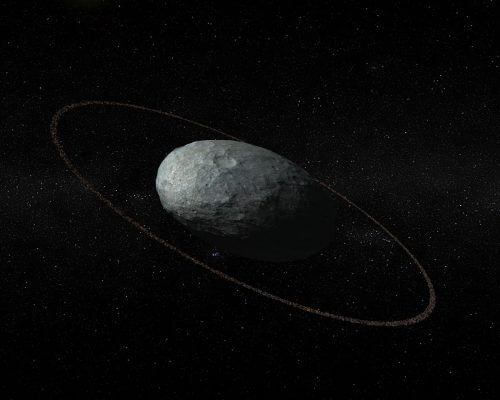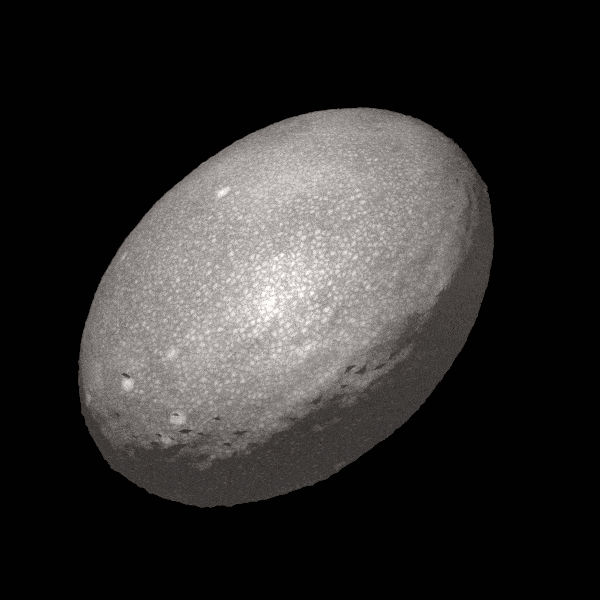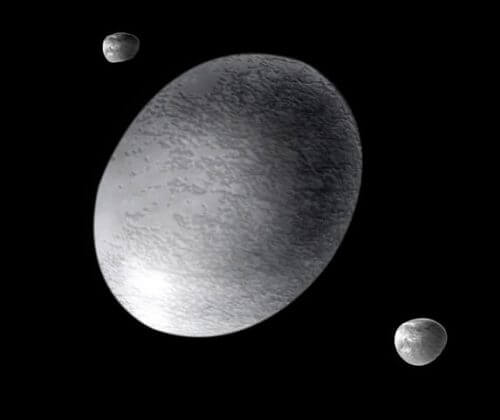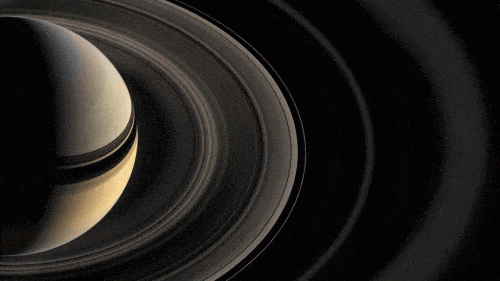An extensive campaign of observations from 12 telescopes was able to locate a planetary ring around the Omia dwarf planet. This is the first ring discovered around a dwarf planet, and the third in the solar system discovered around a body that is not a gas giant.

In a new study Published Yesterday in the journal Nature, an international team of researchers reports that they managed to discover a planetary ring around the dwarf planet The Ummah.
Even without its planetary ring, the Omiya is one of the strangest celestial bodies in the solar system - it completes one revolution around itself every 3.9 hours, faster than any other body in the solar system with a diameter of over 100 km. The rapid self-rotation stretches the umami, giving it shape ellipsoid Reminds me of a squashed soccer ball.
The Omiya is located at the edge of the solar system, in the machine region Kuiper belt. Its current distance from the Sun is about 50 times that of the Earth from the Sun, and it completes one revolution around it every 284 years. Discovered in 2004 and named after the goddess of fertility from Native Hawaiian mythology, the Omiya is one of four bodies in the Kuiper Belt that are officially recognized by the International Astronomical Organization as dwarf planets (including Pluto).
Due to their enormous distance, together with very low brightness and small size, it is very difficult to study and measure the characteristics of bodies like the Omiya, at least not with regular astronomical observations. Therefore, instead of a direct observation, the researchers took advantage of an astronomical event in which the Omiya passed over a distant star and hid its light for a short time, like an eclipse.
"When the light of a star is hidden by a body in the solar system, we can measure how long it takes and from that determine the size of the body responsible for the hiding, because we know the speed of the body in its orbit", explained to the Horizon website Jose Luis Ortiz, head of the team of researchers from the Andalusia Center for Astrophysics in Spain.
The eclipse of the distant star by the Omiya, which occurred on January 21, 2017, was predicted in advance by the team of researchers, and was recorded simultaneously by 12 telescopes from 10 different observatories across Europe.
To the researchers' surprise, in addition to the main dimming in the starlight, created by the Omiya, they detected two smaller dimmings before and after the main dimming. The researchers concluded from this about the existence of the planetary ring that is responsible for the sub-dimming.
The planetary ring is uniform and extends over about 70 km. It encircles the umiya around its equator in the distance of about 1,000 km from the surface. The ring is inspin-orbit resonance of 3:1 with the umiya - when this means that for every one revolution of the ring particles, the umiya makes three revolutions around itself.
In addition to the discovery of the ring, the observation allowed researchers to more precisely determine the dimensions of the Umayyad itself. The length of the long axis of the Omiya is about 2,320 km, much more than the researchers estimated so far, and very close to the diameter of Pluto (although the comparison is a bit problematic - Pluto is more massive, and is not elongated like the Omiya). In order to illustrate how stretched the Omiya is, it is worth noting that its smallest axis is more than 2 times smaller than the long axis - and only reaches about 1,020 km.
Along with the known mass of the Omiya, the researchers also discovered that the density of the dwarf planet is smaller than previous estimates, and more similar to other Kuiper belt bodies, such as Pluto.
the researchers brought up in their research the possibility that the new measurements are not in line with the owner body hydrostatic equilibrium, a situation in which the gravity of a body is strong enough to overcome the forces of its rigid body and obtain an "almost circular" shape. This is one of the conditions that the International Astronomical Organization fix in 2006 for the definition of a dwarf planet, so the new study may open a debate regarding the cancellation of the definition of the Umiya as a dwarf planet.
The study rules out the possibility of the existence of an icy atmosphere of nitrogen or methane around Umia, like the one that surrounds Pluto - this is because the dimming of the distant star's light occurred suddenly and not gradually, as would be expected if Umia had an atmosphere.

How was the Omiya planetary ring formed?
The obvious question that arises from the surprising discovery is how does a planetary ring form around a small body so far from the sun?
It is possible that one factor, a powerful ancient collision, is responsible for all of the strange features of the Omiya, including its planetary rings. Such a collision might have accelerated the Umi's self-rotation, as well as explain the formation of its two small moons, Hayaka and Nakama.
In addition, the Omiya shares very similar characteristics with several other bodies in the Kuiper Belt. These bodies are in a similar orbit to that of the Omiya, and they all have a surface composed mainly of water ice. This similarity led to hypothesize that the origin of all these bodies is in Haomea, and that they were formed in an ancient collision that removed part of the outer ice shell of the dwarf planet.
The same collision could also explain the Omiya's planetary ring: a lot of material thrown into space by the collision could have crystallized over time into a planetary ring.
another option raised is that the ring was formed by material thrown into space from the surface of the Omiya, following its rapid self-rotation.

Planetary rings - not only around the gas giants
Until the last few years, no planetary rings were known in the solar system except those that adorn the gas giants, with the most well-known and famous of all being of course the rings of Saturn. In recent years, however, this picture has begun to change.
The first discovery of a planetary ring around a body that is not a gas giant Announced in 2014, by the same team of researchers from the current study, and was done even then with the same method of hiding the light of a distant star. The researchers then discovered planetary rings around the centaur Chariklo 10199. A year later they discovered another ring around a second centaur, Chiron 2060.
centaurs They are small, icy celestial bodies whose orbit around the Sun is between Jupiter and Neptune. The two centaurs around which were discovered much smaller rings than the Omiya, with a diameter of about 200 to 250 km. Despite their small size, centaurs are believed to have been created further away from their current location, and may even be from the same area where the Omia is, the Kuiper Belt.
In the introductory article For the new study in the journal Nature, MIT planetary researcher Amanda Sicapose raises the possibility that the new discoveries, both around the Omiyas and around the Centaurs, indicate that planetary rings are not such a rare phenomenon in the solar system, and that it may even be more common in the Kuiper belt region the distant "The authors' discovery raises the speculation that ring systems in the outer solar system are not uncommon, and that we can expect new discoveries in this region," Sikapooz wrote.

See more on the subject on the science website:
- Rings were discovered around an asteroid for the first time
- Has the mystery of the formation of Saturn's rings been solved?
- Rings in Super Saturn
- A new body in the solar system has been named: the Umeya dwarf planet
- Why does a group of researchers want to reopen the debate on the definition of planets?
- A new dwarf planet has been discovered at the edge of the solar system
